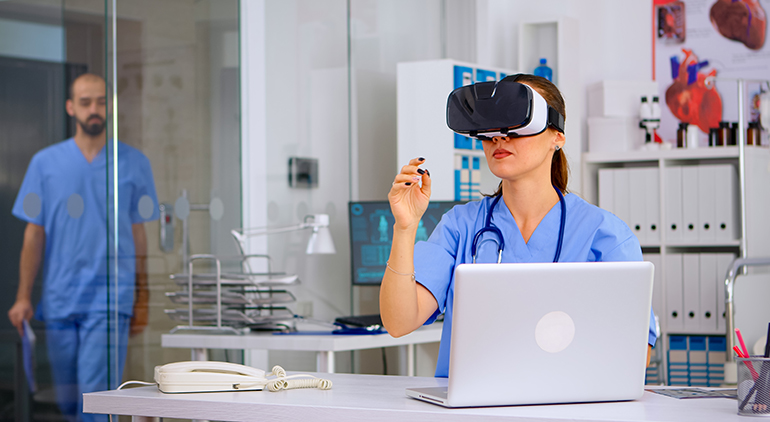How Simulations in Nursing Education Are Transforming Training

With the tremendous change healthcare is going through today, training methods in nursing education must meet the challenge on an industrial level. This transformation is at the forefront of nursing education simulation, which offers educators powerful tools to bridge that gap between theoretical knowledge and application.
In this blog, we explore how simulations are changing nursing training, building student confidence, and ultimately improving patient care.
What do the statistics say?
Results of a meta-analysis showed that SBL significantly increased skill acquisition (SMD = 1.62) in nursing students as compared to traditional methods. Obtaining this statistic reflects the importance of including simulation within nursing.
Additionally, research shows that 90% of nursing students who took part in simulation-based training felt more prepared with their clinical skills when they began internships.
In a study, 98% of nursing students who participated in VR simulations recommended the use of virtual reality in nursing education.
Simulation in Nursing Education: Understanding Simulation
Simulation-based learning (SBL) is a pedagogy that gives nursing students the chance to participate in real-life clinical scenarios without the risk of real patient interaction.
Nursing simulation technology allows educators the ability to create immersive learning environments in which students practice important skills, make decisions, and 'fail', all in a safe environment.
It has been demonstrated that SBL can significantly boost learning outcomes. Simulation-based education was found to improve nursing students' understanding (SMD = 1.31) and self-confidence (SMD = 1.93) when compared to traditional methods of teaching in a classroom for higher education. This evidence supports the contention that simulation labs are an important part of modern nursing curricula.
Summing up the key takeaways from this blog-
Nursing education using simulation is highly effective in helping students to develop both theoretical knowledge and clinical skills, with the literature suggesting that VR training is more effective in readiness with respect to real-world applications than conventional methods.
VR technology promotes higher engagement levels from nursing students, with immersive and interactive trains of thought mimicking clinical environments to promote a boosted willingness to learn.
By delivering a VR simulation, students can practice clinical skills in this psychologically safe space where neither they nor the world can get hurt, fostering learning from mistakes and externalizing growth of confidence.
VR exploits the benefits of participating in nursing education more than regular simulation methods and is able to accommodate more students in immersive learning experiences, which is a solution to problems of clinical placement and resource limitations.
VR Technologies In Healthcare
VR technologies in healthcare have been further integrated into healthcare. Students can practice complex procedures, including administering medication or performing emergency resuscitation, in a virtual simulation where they immediately receive instruction feedback.
A good example is this study, which reveals some of the effectiveness of this new method of learning, by revealing that 96.3% of students felt more confident with virtual reality for medical education. simulation felt more prepared for clinical practice.
Applications of Simulation In Institutes
According to Barbara Davies, Associate Professor in Nursing at Northumbria University, “One of the greatest benefits of simulation-based education is that it offers opportunities to practice and rehearse skills in situations that faithfully replicate key features of the real-world environment.
Let us look at the exact reasons why so many educators today find VR-based technologies in medical education and training medical education and training helpful-
Emergency Response Training:
For example, high-fidelity simulations of emergency situations are used in nursing programs at, for instance, the University of Maryland. Through these scenarios, students are able to practice critical thinking and teamwork under pressure while practicing cardiac arrest or trauma care.
Pediatric Care Scenarios:
Simulations at the University of Cincinnati allow students to hone their skills to care for young patients, in pediatric emergencies. They can assess and respond to a child's unique health needs because of these realistic scenarios.
Chronic Disease Management:
The University of Florida simulation programs include chronic disease management scenarios that allow students to practice long-term patient care strategies.
Interdisciplinary Team Training:
Nursing and medical students are being prepared for real-world healthcare environments where teamwork is essential by simulation-based learning, in institutions such as Johns Hopkins University.
To enhance Critical Thinking and Clinical Skills.
It not only stimulates technical skills but also helps develop critical and sound decision-making abilities. Students learn to tackle complicated clinical situations by participating in realistic scenarios so they can build both skills and the confidence needed for functioning in practice.
A Safe Learning Environment.
The advantage of simulation is that it provides a psychologically safe environment for learners. In the typical clinical setting, students' fear of making mistakes can impede learning, but simulations help students try things without putting patient safety at risk. They help build a culture of learning where reflective practice and feedback are fully embedded in learning practice.
Nursing Education in the Future
The introduction of clinical simulations in nursing courses will continue to evolve based on its integration with technological advancements as we look ahead. Given that research supporting its efficacy continues, SBL will probably become even more widespread in nursing curricula around the world. Adapting these technologies and teaching science with VR labs to meet the needs of their students and to provide high-quality training experiences will continue to be a challenge for educators.
.png)
.png)



